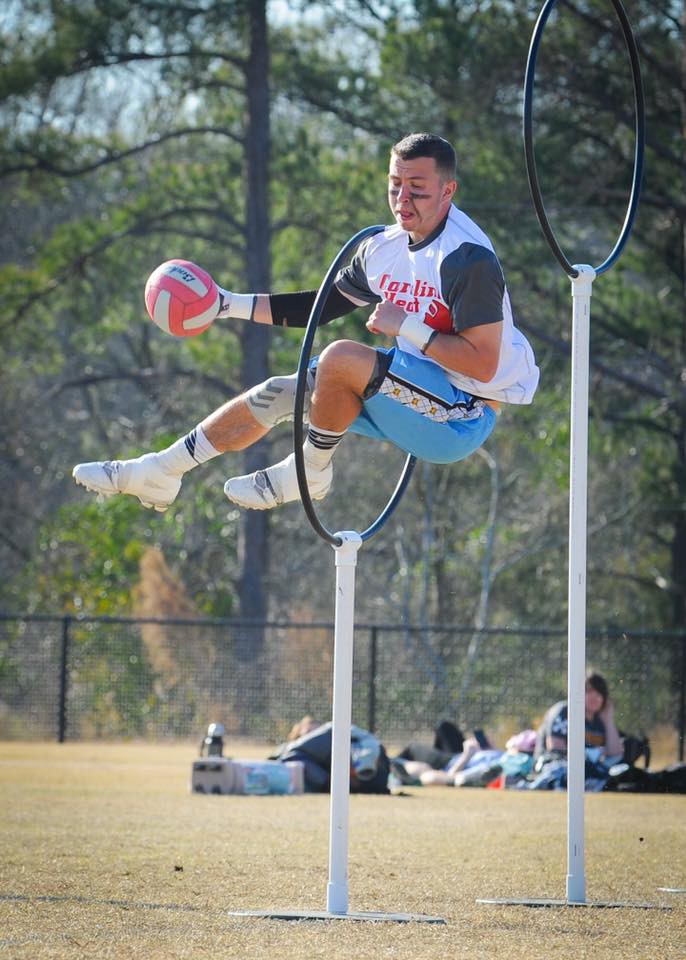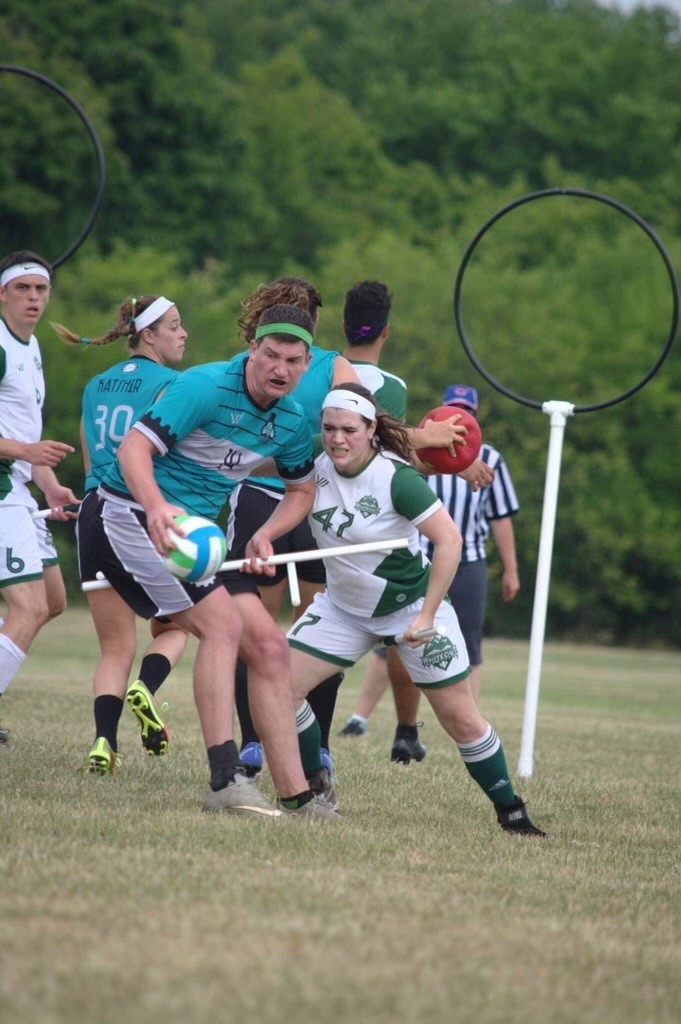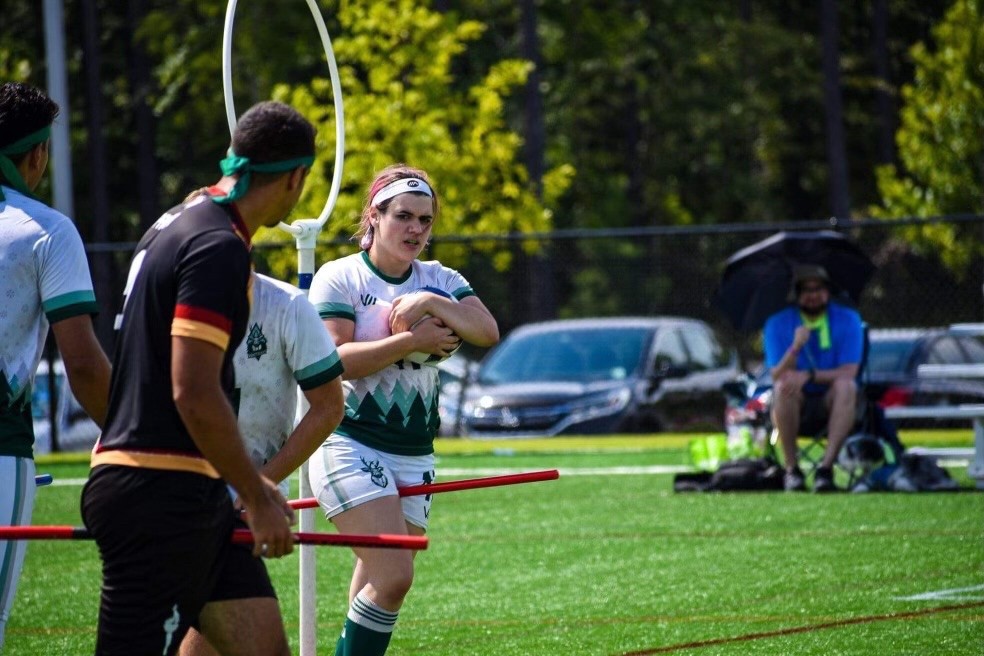Quidditch’s Gender Inequality Problem
Quidditch’s Gender Problem
The Harry Potter-inspired sport’s treatment of female and nonbinary players reveals hesitancy to make all sports more inclusive.
The same thing that lured Chris Champitto to start playing Quidditch in the first place nearly led to quitting the sport a decade later: the people.
The chill that clung to the early November morning in 2018 started to fade before Champitto’s second game in Prince George’s County Maryland.
Champitto, who uses they/them/theirs pronouns, felt excited having just won the last one. Before the game, as per regulations, the referee asked the two captains if any players on their teams identified as a gender that would not be obviously apparent. Champitto came out as nonbinary earlier in the season, so their captain called them over to the center of the field.
They trotted over, dark hair in a military cut close to their head, decked out in ashy war paint inspired by The 100 TV series, and introduced themselves to the referee and the other team’s captains. After Champitto turned around to leave, they heard the other captains discussing them.
“Are you sure [they’re nonbinary]? Like, how do we know?”
This moment arrived during a season-long struggle during which Champitto dealt with Quidditch players throughout the country accusing them of making up their gender identity to give their team an advantage. They didn’t play during that game, and they retired after that season. “They kind of like dementor-kissed all the warmth and happiness out,” Champitto says, referencing ghoul-like creatures in the Harry Potter series by J.K. Rowling, who feed on happiness and suck the souls out of people.

An apt analogy considering the game of Quidditch originates from the world of Harry Potter. Brought from the pages to reality in 2005 at Middlebury College, Quidditch now boasts 25,000 players around the world, according to the Quidditch Premier League — a European summer semi-professional league. In other co-ed leagues, additional gender rules are tacked onto the existing sport — such as a female player needing to touch the ball in co-ed volleyball before hitting it over. However, the gender rule in Quidditch holds as much importance as any gameplay requirements, such as the requirement to keep the broomstick between players’ legs. The rule requires that a maximum of four players of the same gender be on the field at the same time. Despite this gender rule, many female and nonbinary players have been treated as inferior athletes to their male counterparts.
Susan Cahn, historian of women and sexuality in the United States with a sports focus, offers one reason for inequality between men, women, and nonbinary players on the pitch. “Sports has really been a bastion of male power and privilege,” she says, adding that sports exist for men to preserve and prove their masculinity. Her argument includes the massive gender pay gaps in professional sports, the mistreatment of WNBA players during the initial COVID basketball bubble, and the ongoing push to make women’s sport uniforms less revealing. But Quidditch, at its core, strives to provide relief from these ongoing forces, as the Harry Potter fandom has historically offered acceptance and community.
However, during the summer of 2020, Rowling who originally conceptualized the game of Quidditch made hateful comments toward transgender women. These comments enraged fans who felt betrayed by her oppressive views. Since then, the Quidditch sport community has issued statements to disaffiliate with her and affirm Quidditch’s commitment to inclusivity.
So players like Champitto, who recently realized their gender identity, thought the Quidditch community would accept them, making the backlash that much worse. Between their jumping ability, slim but defined muscles, and competitive spirit, they have been a valued and prominent figure since they started playing back in 2008.

One reason Champitto suspects people doubted their identity stems from their competitive nature. Another reason, though, comes from history within the sport as there have been a few male players who have lied about being nonbinary in the past to try to give their team an advantage by having more male players on the field.
Players who identify outside the gender binary are held in separate categories for each gender identity represented, so for example a nonbinary player and a gender nonconforming player would be separately categorized. This means players pretending to be nonbinary could play as a separate gender minority — often taking women’s spots.
This idea of female inferiority followed Alyssa Giarrosso through her first few Major League Quidditch teams in upstate New York. She was held to a much higher standard than her male counterparts and would be benched after dropping a pass or missing a shot.
Fellow player Jess Daly reported similar experiences in her years playing at the semi-professional level. “Unfortunately, a lot of female and gender non-conforming players tend to get kind of pigeonholed on their teams,” she said, referencing her experiences being benched for similar minor mistakes Giarrosso described.
Daly doesn’t think there’s mean intent, rather, players consider gender inequality the norm and just part of “the way the team works.” Her newest team, The Boston Pandas, divided the team into a three maximum gender division. Meaning, the team will never have more than three players of the same gender on the pitch at the same time. This team has received a lot of criticism within the Quidditch community for this decision; Daly’s heard others say that a three maximum creates a disadvantage, makes it less competitive, or even that it will “ruin the sport.”
This type of response supports Cahn’s argument that as women have entered sports, men have resisted and seen women’s involvement as a threat. Now, the increase of transgender and nonbinary athletes has thrown the athletics as a whole into reconsideration.

“We still function in a binary system but that’s not how gender actually works,” Cahn says. “Transgender athletes have been really important for pointing that out, that we’ve organized sports around something that’s partially fiction.”
Having men and women work together in a space designed around teamwork can start to reduce these discrepancies, which Adam Cohen focused on in his dissertation. Now, Cohen researches and teaches at the University of Technology Sydney in the intersections of youth sports and social justice. During his dissertation, Cohen studied the sport of Quidditch to see if a full-contact, co-ed sport could start to reduce gender stereotyping. Over six years ago, he found that Quidditch succeeded at starting to eliminate preconceived biases, but Cohen now says, “the sport was a little less competitive, and it was more about the whimsy.” He emphasized that as sports increase in competition, they decrease in inclusivity. “It is really tough to correlate competition and winning with inclusivity and equality. Usually you have to prioritize one versus the other,” he says.
At the highest level of sport competitions, people tend to be intolerant of transgender athletes — evidenced by a now-removed petition to ban transgender athletes from competing at the Olympics in response to the first transgender Olympic weightlifter — but Cohen argues while that intolerance should not be permissable, it’s not the root problem. He says that only the top 2% of athletes compete at that level and worries more about the rest of us. “What do we do with the other 98% of trans athletes that want to run around with friends, that want to play, want to kick a ball, where do those opportunities come from?”
Though no comprehensive studies exist in America about transgender or nonbinary athletes, a study by Birgit Braumüller, Tobias Menzel, and Ilse Hartmann-Tews in 2020 examines how LGBT athletes have been treated in Europe. The researchers found less biases against LGBT athletes than in comparable studies from 2012 and 2017, but LGBTQ discrimination still exists in sports, especially for non-cisgender athletes. The study concluded that though a number of LGBTQ athletes have faced discrimination, transgender and gender nonconforming athletes face institutional level challenges, because sports, in general, do not have the structure to support them.

Within the United States, 29 states have passed or proposed youth transgender sport bans, preventing transgender girls from competing in sports at the high school level. For George Cunningham, professor of health and kinesiology at Texas A&M University who does research in diversity in sport, this ban doesn’t make much sense. He argues high-school sports should foster relationships and a community, not just focus on winning. Plus, with the proven importance of physical activity for young people, athletics boost health.
The Trevor Project, an American nonprofit focused on suicide prevention efforts among LGBTQ youth, found that 20% of LGBTQ individuals identify as nonbinary and that nonbinary and transgender individuals participate in sports significantly less than their cisgender peers. Because of this lack of inclusive spaces within athletics, Quidditch, in theory, offers a respite for people who want to stay active, but struggle to find accepting communities.
Many levels of leadership try to tackle the goal of true inclusivity within Quidditch. US Quidditch (USQ), a governing and organizational body who oversees competitions during the year and hosts the collegiate level, holds the power to set the rules of the game and focuses on keeping the game safe and inclusive. Mary Kimball, USQ’s director, says the organization works on multiple levels to reduce the prevailing inequality. For example, USQ tweaked the gender rule from a minimum of two players of the same gender, to a maximum of four players of the same gender on the pitch at a time. While this change may seem minute, during parts of the game, there can be a maximum of seven players on the field. This change frees up more spots for players in the gender minority on the pitch.
Another solution involves making the harassment-reporting process smoother, gathering data on gender divisions with Quidditch teams, and promoting players from diverse backgrounds on social media accounts and their website. “But there’s a lot more that we need to change,” Kimball said. “I’d say the effects are minimal right now. But the good thing is that if someone does report harassment or assault to us, I think, the process will be a lot more supportive and engaged.”
Even with these minimal implementations by USQ, many players have been more proactive in advocating and promoting gender inclusivity themselves. The other league in the U.S., Major League Quidditch (MLQ), competes during the summer and plays at a semi-professional level. For the first time in 2021, they hosted a fantasy no-stakes tournament called “Take Back the Pitch,” which served as the first tournament focused exclusively on non-male players, showcasing female, nonbinary, and transgender players.
“We really wanted to try to be as inclusive as possible to those outside of the gender binary,” said Daly, the Boston Panda player and one of two main tournament coordinators. “To be sure they felt like this was also for them.” Players competed the day after the MLQ championships, a Monday in August 2021. Despite the heat, they had 64 players compete in four teams of 16 people.
At the tournament, Daly stepped into the game in the beater posiition for the first time ever. While playing, she noticed the games stayed at the same level of competition as the championship tournament the day before, “which was kind of the whole point, to prove that we can do everything that they can,” Daly said.
Now on the Boston Pandas team, after playing in Miami, Atlanta, and New York, Daly said she feels much less pressure while playing. If she drops a pass or wants to try a new position, others encourage her to do so, instead of punishing her for little mistakes.
While Daly’s influence takes place within MLQ, other players, such as Giarrosso change things from a different perspective. She coached a recreational league over the summer. As a player, she taught herself to stop apologizing, so over the summer she never punished someone for making a mistake. While coaching, she prioritized teaching basic skills, like throwing and catching. “We don’t make people feel less than for not necessarily knowing things, and I think it really helped,” she said. “This was probably the happiest I’ve ever seen a Rochester team. I think we’re gonna have good retention because of it.”
The season before Champitto decided to quit, at a cold tournament in Rochester, Champitto walked across the field between games, thinking about enjoying Rochester’s signature garbage plate later. As they walked, they picked up pieces of a conversation from two players they didn’t know. Champitto quickly realized the two were talking about them.
One of the players misgendered Champitto, using “he/him” pronouns. Within seconds of the error, the other player, who Champitto had never met, corrected their friend, telling them to use “they/them” pronouns. In that moment, the garbage plate left their mind, the world could have stopped spinning as Champitto stood in their own little bubble of warmth. A thought crossed their mind.
“This is what belonging feels like.”
is a senior, magazine journalism and writing and rhetoric major and a digital producer for The NewsHouse.
About
This Project Our StaffExplore
Equal Shot Enforcing Equity No ExceptionsThe S.I. Newhouse School of
Public Communications
215 University Place
Syracuse, NY 13244


